Under the waterline
“Ming H2 Wu: Immersion” opens Saturday at the Palos Verdes Art Center
by Bondo Wyszpolski
They’re graceful and sensual, these young women, as they seemingly glide or drift in their gowns or among strands of tissue-thin fabric. They’re also several feet underwater.
“Immersion” is a set of 39 images photographed by Ming Wu, better known as Ming H2 Wu, and these works will be on view from July 20 (reception from 7 to 9 p.m.) through August 17 in the upstairs Norris Gallery at the Palos Verdes Art Center.
Ming’s background is in commercial photography and his aesthetic sensibility has carried over well from the studio or set to the backyard swimming pool. I recently visited Ming at his home in Gardena and spent an evening with him and his wife, Maryl Velbeck, who does hair and makeup, finds props and costumes, and is always on hand to assist Ming’s models in or out of the water.

You’d think it’s pretty easy, pretty straightforward: Find someone to jump into the pool, swim around for a few minutes, click, click, click, and the session is done. Well, no, there’s a lot more to it than that as you’re about to discover.
Some of the models he’s worked with before, Ming says, mentioning that he formerly had a studio in downtown L.A. Occasionally, one model recommends another while others have a viable presence on social media. Or, as Ming puts it, “I’ve never really had trouble finding a model to work with us.”
Maryl is quick to elaborate. “Before each photo shoot we send out a photo call sheet, and it has what to bring. Many of the models have a dance background, and they hear about us or they meet us through our commercial projects. Many of them are from agencies. Surprisingly enough, we’ve had some models that are with Cirque du Soleil who have acrobatic backgrounds. We had a fire dancer — she wasn’t doing the fire dancing underwater, obviously — who was very acrobatic, so it was really cool to watch her because these people can do the same thing underwater that they can do outside of the water. They have a lot of cool props from having that type of background, so it’s really fun to work with them.”
While props of some kind are essential, whether it’s just a wig or a long flowing scarf, it all begins with stepping into the swimming pool. But as Ming points out, “Not everybody is comfortable in an underwater environment.” Furthermore, “swimming pool” in this case is a misnomer, because the model is not swimming. In fact, she (or sometimes he) is not even holding in her breath.
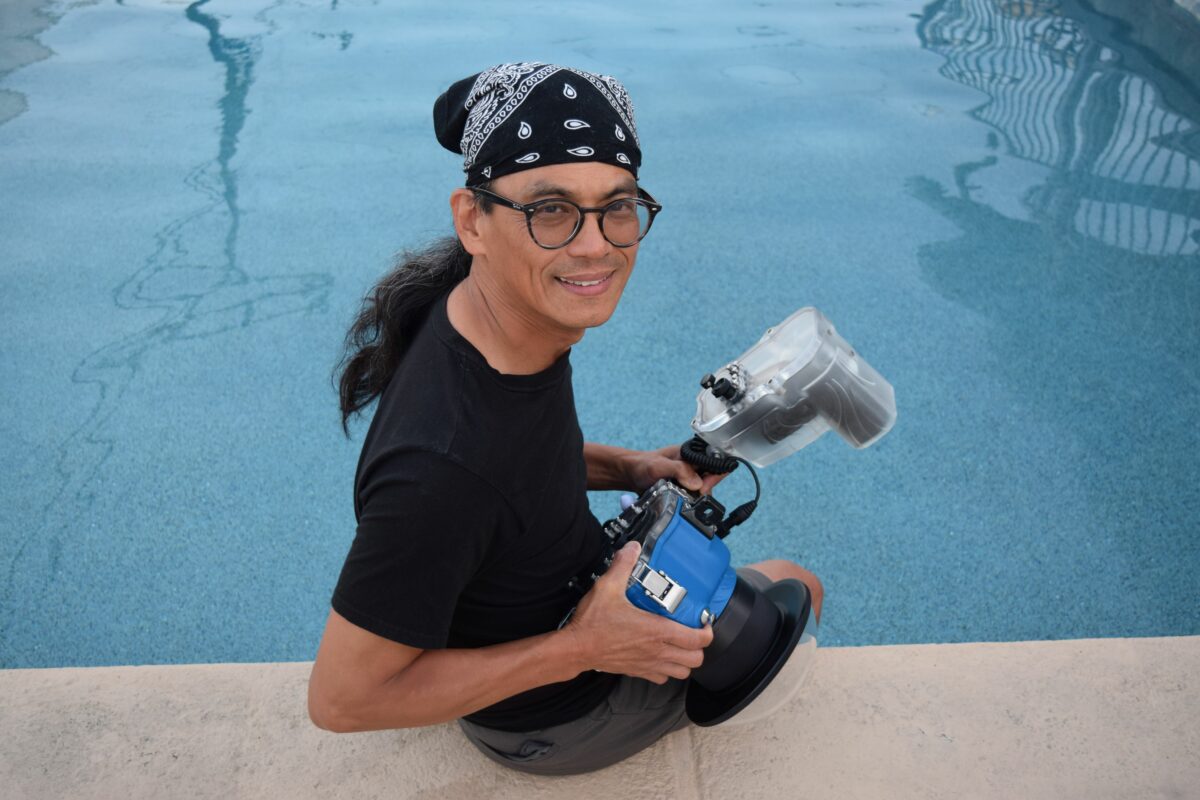
When a model participates for the first time, Maryl explains, there’s a kind or orientation they go through before the session can actively begin. “Ming gets into the water with them,” she says, “because when you swim you’re holding your breath, but when you do what we’re doing you want to sink, so you let the air out. When you do that, you sink. We hope.” She laughs. “Some people don’t. But no matter what, Ming is an accomplished photographer so at least he does get something wonderful for them, for their coming all the way here and trying it out. But yes, the majority of the people can do it, and that’s how we get our photo shoot together.”
If one glances through Ming’s website it’s fairly evident that by and large the women are young and fairly attractive. Admittedly, a scantily clad octogenarian wouldn’t be quite as alluring, but I did have to ask why there weren’t any older and less attractive subjects. You know, like me, I said, who’s older and not so attractive.
“You can do it if you want,” Maryl says.
Ming replies that it’s about the situation, and about finding those models who actually are up for doing this kind of shoot.
“The reason they’re younger,” Maryl tells me, “is because they all know each other.”
But that’s just one part of it. “There’s a lot of energy involved,” Ming says. “It’s not like a normal studio photo shoot; it wears people out pretty quick.”
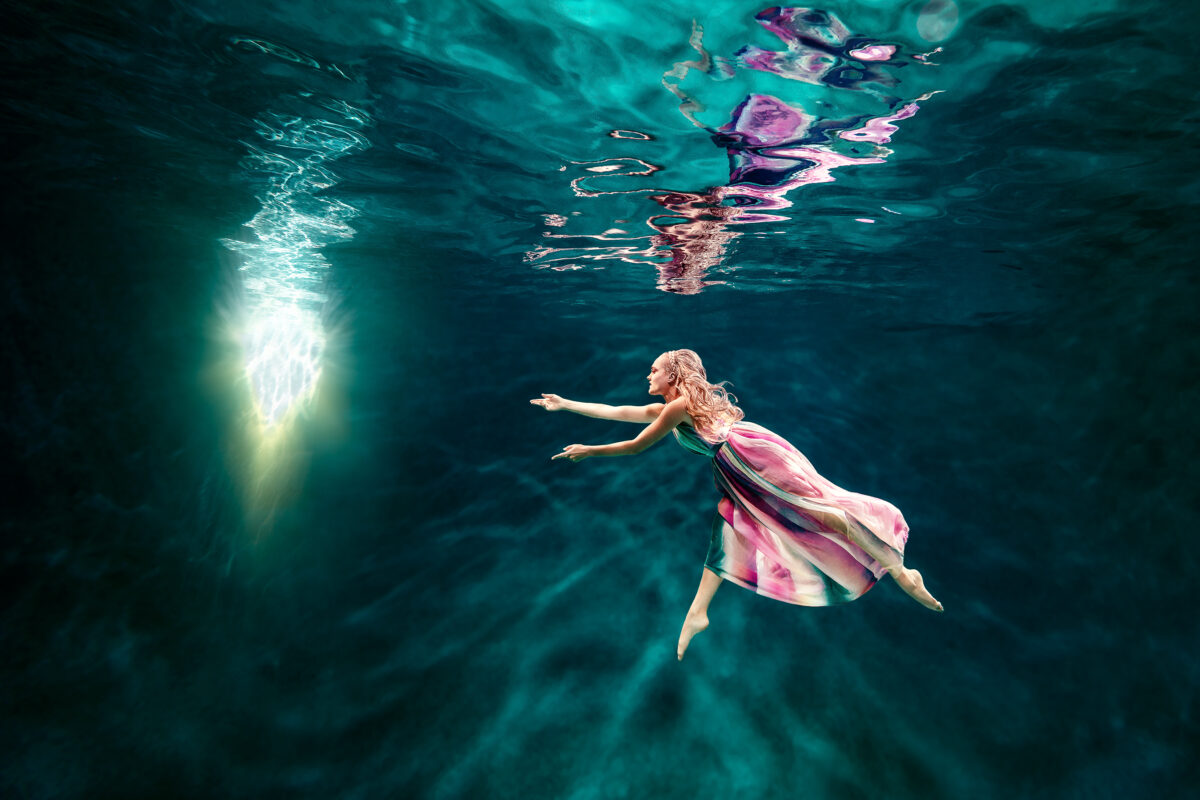
“Because what you’re doing,” Maryl interjects, “is you’re up and down and up and down and you’re not holding your breath or swimming or any of that. You go underwater and you have to think about a lot of different things at the same time.” For example, she continues, “You have to keep your toes pointed, you have to keep your hands looking good. If your hands are like this they look too large (because of the distortion caused by the water). It’s not an easy thing.”
There’s a lot of thinking involved, Ming says in affirmation.
“It’s really kind of labor intensive,” Maryl adds, and that’s the primary reason there aren’t a lot of older folks lined up at the door, ready to cannonball their way into one of Ming’s underwater photo sessions.
Even so, younger people who may seem physically fit can get in over their heads, figuratively, but also literally.
“The first year I was doing an underwater photo shoot,” Ming recalls, “I was hired by an actress.” For this shoot they had to go on location, which gave Ming and Maryl less control over the situation.
“She was very nervous,” Ming continues. “Before the photo shoot she drank a bottle of champagne…”

Maryl then fills in the details: “What happened was… I’m also the safety person on the set. If you look like you’re in trouble I will come in and fish you out — and that’s what I had to do.”
On that particular day Maryl wasn’t the makeup artist since the project was for a magazine editorial and there were other makeup people on hand as well as multiple models. “I was doing the safety thing,” Maryl says. “She (the actress) came up out of the water and I said, ‘Are you okay?’ and she said ‘No’ — and she sank like a rock, in about nine feet of water.”
Maryl then jumped in and brought the woman back to the surface. (If there’s a moral here, maybe it’s “If you drink, don’t dive.”)
“Sometimes the model wants to try too hard,” Ming says. But because he’s been doing underwater photography now for so long he can see when someone is struggling.
Both Ming and Maryl mention repeatedly that “safety is our number one concern.” There’s no margin for error when people are in the water. That’s why Ming gets into the pool with them and makes sure they’re comfortable and aware of what they need to do before he picks up the camera to take pictures.
Rising to the surface
Ming Wu is originally from Taipei, Taiwan, and he moved to the United States in the mid-1990s. He earned a B.A. in commercial photography from the Brooks Institute of Photography in Santa Barbara, and went on to get his M.A. in photography from Scripps College of Visual Communication at Ohio University. The knowledge he’s acquired over the years is on display in a textbook he authored called “In Depth: The Rise of Underwater Model Photography.” It not only contains a wealth of images, but explains what went into each shot, from lighting to camera angles.
Although he has been shooting underwater since 2005, it was in 2021, during the pandemic and when outside jobs were scarce, that he began to focus more on his fine art photography. That was when he discovered the Palos Verdes Art Center and specifically PADA (Photographic and Digital Artists), one of the center’s eight groups. Later he also joined TAS (The Artists’ Studio), and soon enough his images were on view in both the annual summer and winter shows.
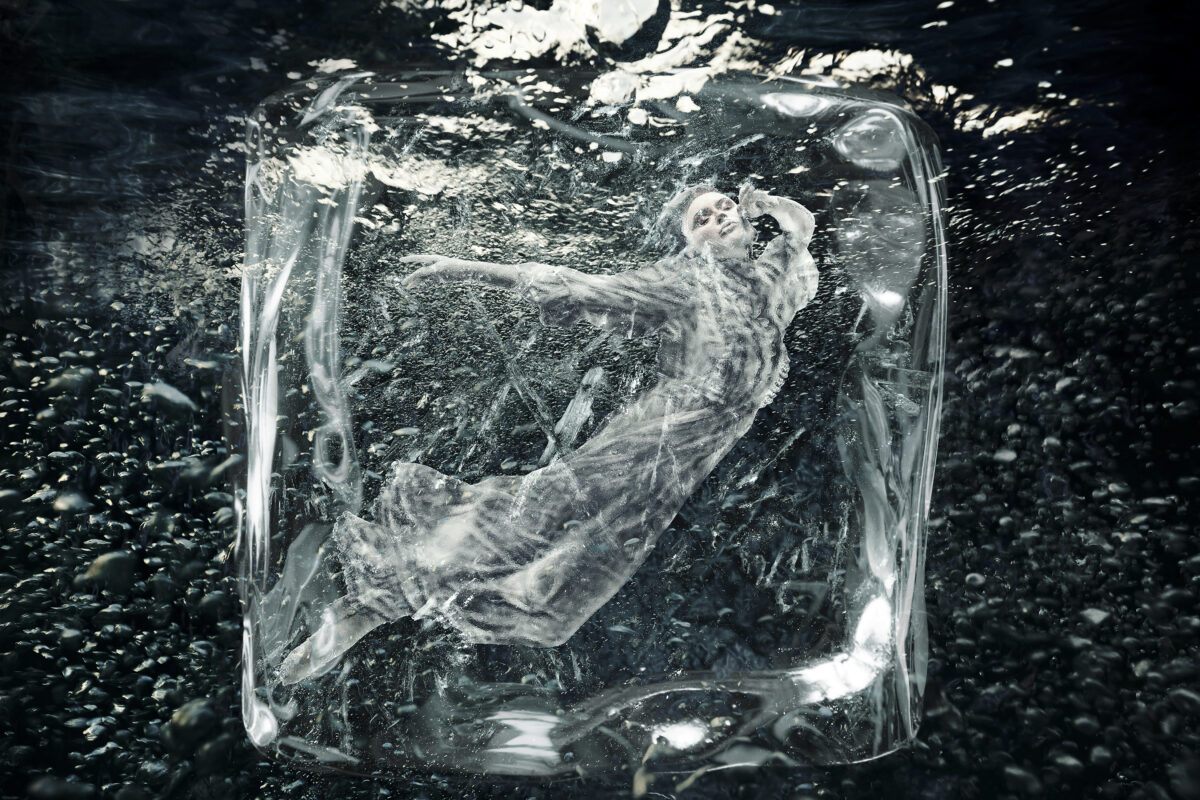
Two years ago, encouraged by his new friends and colleagues, Ming began exhibiting his works at the Malaga Cove Art on the Lawn shows, which typically occur one weekend a month from May through October.
He was anxious and hesitant at first because he had no idea whether anyone stopping by might want to purchase his pictures. However, any apprehension he had beforehand quickly vanished: Ming’s underwater photography sold quite well.
The interest in his work didn’t escape the attention of Daniela Saxa-Kaneko and others at PVAC. “Two months ago,” Ming says, “they called and asked if I would be interested to have my own solo show.”
That’s how “Immersion” came about. Maryl feels that the reason why Ming was asked, apart from the unique and sensual quality of his work, was because the venue hadn’t presented a solo photography show for quite some time. Additionally, “Immersion” seems to complement the easygoing mood of “The Summer Show” with its air of long days and warm weather. And of course being a member of PVAC is certainly a plus, an opportunity for one of the center’s own to be highlighted, which isn’t always the case.
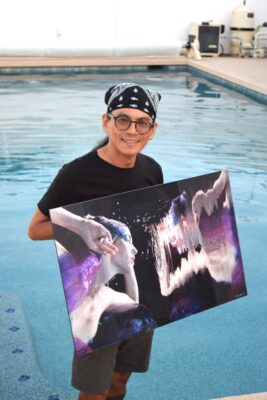
Of “Immersion’s” nearly 40 prints, the largest is 48×48 inches, with the others ranging in size from 24”x16” to 36”x24”. Ming himself chose the works (“Actually, I’m pretty organized,” he says), and furthermore he made a mockup of the exhibition space and where he thought each picture should be hung, which he presented to the art center.
I mention that I’ve seen many of the images on his website, but Ming then corrects me.
Photographs that he’s offering for sale or submitting for an exhibition are not, at least for the most part, on the internet. If he were to do that, he says, the image would somehow lose its freshness and its “mysterious feeling” (in his words). And also, what is seen on the screen of our computer or cellphone simply doesn’t do justice to the clarity and dazzle of an archival print. In other words, Ming wants our initial exposure to his new work to make the best impression possible.
“These are newer works,” says Maryl, “and they’re all like A-list.”
However, some of these prints were made earlier, and some of them have previously been on display. After all, why not include your best pieces?
Another reason for Ming not to put everything on his website is because he has collectors, and he likes to give them “a first look,” a sneak preview, if you will, before they’re offered up to the general public. Too many eyes beforehand will steal some of their magic.
Fine art models and mermaids
It seems that there are only so many poses that can be done with someone underwater, and so Ming is asked what it is that compels him to keep doing this kind of photography. One might wonder if over time it simply gets repetitious.
Ming says the sessions are never the same. “Every single photo shoot is always challenging.” For example, there can be a technical malfunction with the equipment, the lighting, the strobe, or the camera itself. And then there’s the natural, outdoor lighting, which is another variable and one subject at times to the whims of nature.
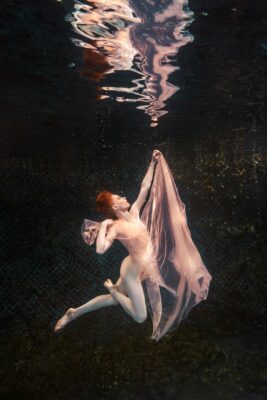
The ideal time for a photo shoot is not when there’s sunlight overhead but rather when there’s no direct sunlight over the pool at all. If there is, the light passing through the water will create a dappling effect on the skin. “Occasionally I’m not working in my own environment,” Ming says; “sometimes I’m on location and in that case you don’t have a choice.” One may not even be able to schedule the best time of day to photograph.
Camera angles and artificial light will then be important in order to minimize distortion and to avoid anything resembling a funhouse mirror effect. This goes back as well to instructing the models how to position their hands, feet, and head.
Before each photo shoot, Ming and Maryl usually have some idea of a concept they’d like to pursue. If it’s a shoot with a first-time model there’s probably more leeway as to what will develop as opposed to working with someone with whom they’ve already established a rapport.
“If it’s not the first time we’ve worked with them and we’re pretty sure they can do it,” Maryl says, “I’ll prepare wigs in advance and color the hair and get special things for the makeup or the concept of the design. We look through things and get backgrounds together, props, costuming, things like that. Some of it has quite the plan to it, and sometimes it doesn’t.”
The result of such preparation is evident in the three categories of “Immersion,” beginning with the outer hallway that leads into the Norris Gallery from below. Maryl says these are older works and examples of their first foray into underwater photography when the sessions were for fashion magazines.
“So the models in those pictures have shoes on, they have full wardrobes and wigs. It was all really beautiful, heavy stuff for them to wear underwater, too. So we have examples of that plus more like fine art models because Ming’s won a lot of awards with his underwater nudes. We also have a pastel collection and a mermaid collection.
“The mermaids,” she continues, “take it really seriously. We had a couple that have come here that have custom tails. These tails cost about $30,000 each and they’re all custom-made out of silicone with scales made of glass. It’s really heavy, too, and weighs about 40 pounds. There’s a picture in the show of one of them.
“That’s another consideration,” Maryl adds, referring to the weight of any outfit that a model may be wearing. “When they’re in the water, if they have a costume, like a wig or even shoes, once they get wet they’re always heavy.”
“That’s the part (of the process) people never see,” Ming says. “They don’t realize how much of a challenge it is.”
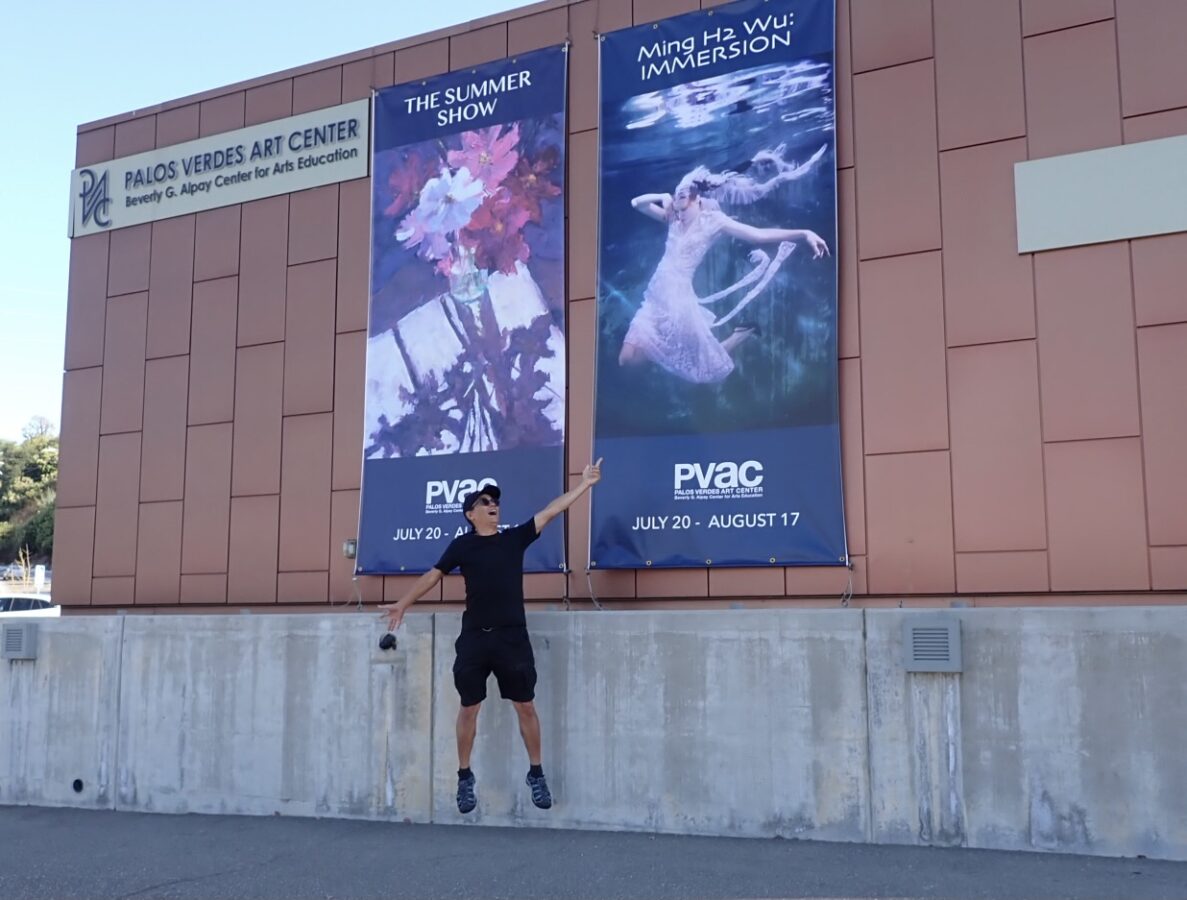
Ming and Maryl assert that they are truly honored to have “Immersion” on view for a few weeks this summer, and Ming expressly thanks his PADA and TAS colleagues for their encouragement.
“And I’m so excited for him,” Maryl says, “because I’ve never seen so much of Ming’s underwater artwork all in one place and all at the same time. And, quite frankly, I’ve never seen so much of my work hanging anywhere because I do all of the makeup and all of the hair. It’s just been a lot of fun to do that.”
Ming H2 Wu: Immersion opens Saturday, July 20, with a reception from 7 to 9 p.m., and remains on view through August 17 at the Palos Verdes Art Center, running in tandem with The Summer Show. Ming’s website is www.h2wupix.com. PVAC is located at 5504 Crestridge Road, Rancho Palos Verdes. Hours, Monday through Friday, 9 a.m. to 5 p.m.; Saturday, 10 a.m. to 4 p.m.; closed Sunday. Free. (310) 541-2479 or visit pvartcenter.org. ER











